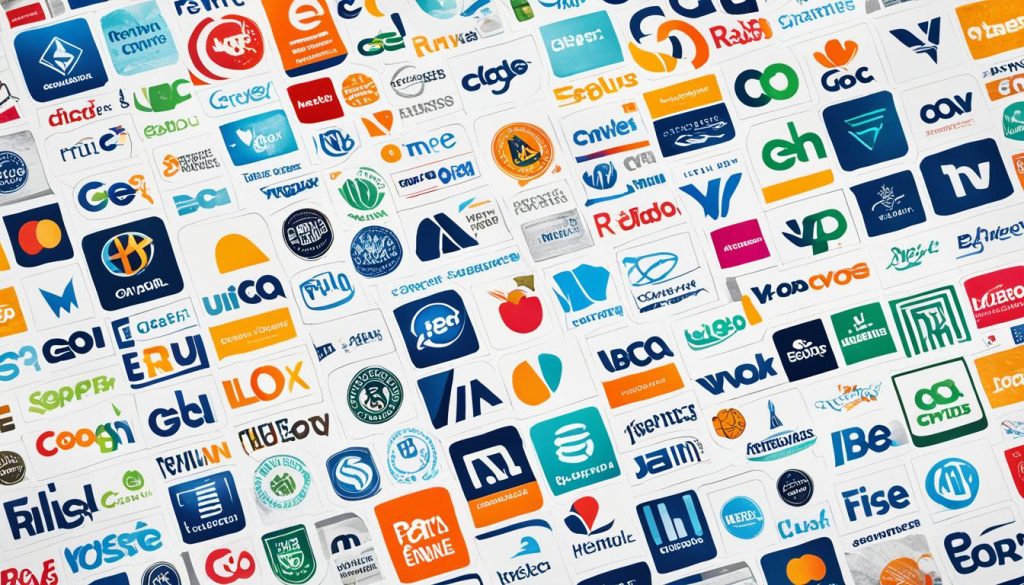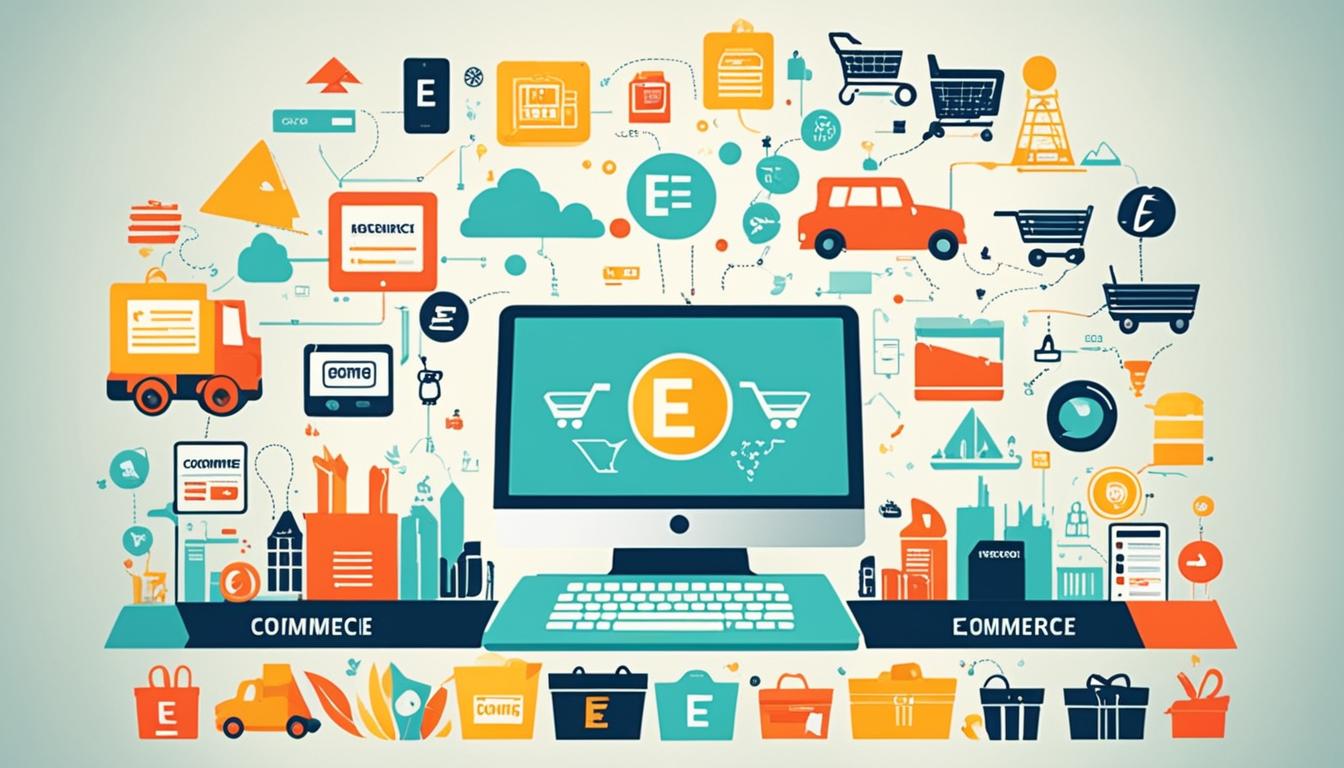E-commerce examples
Did you know that e-commerce sales worldwide reached a staggering $4.28 trillion in 2020? The growth of online shopping has revolutionized the retail industry and transformed the way we buy and sell products. From small start-ups to multinational giants, e-commerce has paved the way for numerous successful online stores.
Today, I will take you on a journey to explore some of the top e-commerce websites and learn from their remarkable success stories. Whether it’s a niche platform or a global marketplace, these examples will inspire you to explore the endless possibilities of online commerce.
Key Takeaways:
- Online shopping has experienced incredible growth, with global e-commerce sales reaching $4.28 trillion in 2020.
- E-commerce has revolutionized the retail industry and transformed the way we buy and sell products.
- From small start-ups to multinational giants, there are countless success stories in the world of e-commerce.
- Exploring top e-commerce websites can provide valuable insights and inspiration for your own online business.
- Stay tuned as we delve into the fascinating world of e-commerce and discover the secrets behind their success.
The Evolution of E-commerce: How It Works and its Advantages
E-commerce has revolutionized the way we buy and sell goods and services, allowing transactions to take place online. Customers can easily place orders through various channels such as online stores, websites, and social platforms. These orders are then processed through a centralized backend system that facilitates the transaction and ensures a smooth delivery process.
One of the key advantages of e-commerce is its convenience. Customers can shop from the comfort of their own homes, eliminating the need to physically visit a store. This convenience factor has greatly contributed to the growth of e-commerce and its widespread adoption.
Another advantage of e-commerce is the increased selection it offers. Online stores can stock a much broader range of products compared to traditional brick-and-mortar stores. This allows customers to explore a wider variety of options and find exactly what they’re looking for.
E-commerce also presents potentially lower start-up costs for businesses. With an online store, entrepreneurs can avoid the expenses associated with renting or buying a physical location. This enables smaller businesses to enter the market more easily and compete with larger players.
International sales opportunities are another benefit of e-commerce. Online stores have the potential to reach customers from around the world, expanding the customer base and increasing revenue potential.
Retargeting customers is another powerful advantage of e-commerce. Through various analytics and tracking tools, businesses can identify customers who have shown interest in their products and retarget them with personalized offers or promotions. This helps to increase customer retention and drive additional sales.
However, it’s important to acknowledge the limitations of e-commerce as well. One such limitation is limited customer service. Although online stores often have customer support options, they may not provide the level of personalized service that physical stores can offer.
Additionally, e-commerce lacks the instant gratification that comes with an in-person purchase. Customers have to wait for their products to be shipped and delivered, which can take time depending on the location and shipping method chosen.
Despite these limitations, the advantages of e-commerce outweigh the drawbacks for many businesses and consumers. The evolution of e-commerce has transformed the way we shop and has opened up a world of opportunities for entrepreneurs.
| Advantages of E-commerce | Limitations of E-commerce |
|---|---|
| Convenience | Limited customer service |
| Increased selection | Lack of instant gratification |
| Potentially lower start-up costs | |
| International sales opportunities | |
| Retargeting of customers |
Types of E-commerce: A Look at Different Business Models
E-commerce operates with various business models, each catering to different types of transactions. Let’s explore the most common types:
1. Business-to-Consumer (B2C)
In the B2C model, businesses sell products or services directly to individual consumers. It is the most familiar type of e-commerce and includes popular online retail platforms like Amazon and Walmart. B2C e-commerce provides a convenient shopping experience for consumers, allowing them to browse and purchase a wide range of products from the comfort of their homes.
2. Business-to-Business (B2B)
In the B2B model, businesses sell products or services to other businesses. This type of e-commerce often involves large-scale transactions and focuses on meeting the needs of business customers. B2B e-commerce platforms enable companies to streamline their purchasing processes, improve efficiency, and foster stronger relationships with suppliers and vendors.
3. Direct-to-Consumer (D2C)
The D2C model allows manufacturers to sell their products directly to consumers without the involvement of intermediaries. This model has gained popularity in recent years, thanks to the rise of social media and online marketplaces. D2C e-commerce offers brands the opportunity to establish a closer connection with their customers, gain valuable insights, and maintain full control over the customer experience.
4. Consumer-to-Consumer (C2C)
C2C e-commerce involves individuals buying and selling products or services to one another. Online platforms like eBay and Craigslist facilitate C2C transactions by providing a platform for individuals to list and sell their used or new items. C2C e-commerce offers individuals the ability to monetize their assets or find unique products from other individuals.
5. Consumer-to-Business (C2B)
In the C2B model, individual consumers offer products or services to businesses. This can include freelancers, influencers, and content creators who sell their expertise, creativity, or promotional services to businesses. C2B e-commerce provides businesses with access to a diverse pool of talent and resources while offering individuals the opportunity to monetize their skills.
6. Business-to-Government (B2G)
B2G e-commerce involves businesses selling products or services to government entities. This can include providing specialized equipment, software, or services tailored to meet government needs. B2G e-commerce streamlines the procurement process for government organizations and fosters transparency and efficiency in public sector transactions.
7. Consumer-to-Government (C2G)
C2G e-commerce enables individual consumers to engage in transactions with government entities. This can include paying taxes, renewing licenses, or purchasing government services online. C2G e-commerce simplifies government interactions, reduces paperwork, and enhances citizen convenience.
These diverse e-commerce models allow businesses to adapt their strategies based on their target audience and the products or services they offer. Understanding these models is crucial for e-commerce success and can guide businesses in choosing the best approach for their specific needs.
| E-commerce Model | Description |
|---|---|
| Business-to-Consumer (B2C) | Businesses sell products or services directly to individual consumers. |
| Business-to-Business (B2B) | Businesses sell products or services to other businesses. |
| Direct-to-Consumer (D2C) | Manufacturers sell products directly to consumers without intermediaries. |
| Consumer-to-Consumer (C2C) | Individuals buy and sell products or services to one another. |
| Consumer-to-Business (C2B) | Individuals offer products or services to businesses. |
| Business-to-Government (B2G) | Businesses sell products or services to government entities. |
| Consumer-to-Government (C2G) | Individual consumers engage in transactions with government entities. |
Selling Goods and Services Online: Understanding the Different Types
E-commerce has provided businesses with the opportunity to sell a wide range of goods and services online. Let’s take a closer look at the different types of products that can be sold through e-commerce.
Physical Goods
Physical goods are tangible products that can be shipped to customers. They include items like clothing, electronics, home decor, and other physical items that customers can touch and feel.
Digital Goods
Digital goods are intangible products that can be downloaded or accessed online. These can include e-books, music, software, online courses, and other digital products that can be delivered electronically.
Services
In addition to physical and digital goods, businesses can also offer services through e-commerce. This includes various skills or offerings that can be delivered to customers online. For example, services like coaching, writing, web design, and influencer marketing can all be provided through e-commerce platforms.
E-commerce platforms have made it easier than ever for businesses to sell a wide variety of goods and services to customers worldwide. By leveraging these platforms, businesses can reach a larger audience and provide their products and services in a convenient and accessible manner.

Revenue Models in E-commerce: Examples of Successful Businesses
E-commerce businesses have a variety of revenue models to choose from, allowing them to generate profits and drive success. Let’s explore some of the most effective models that have led to e-commerce success stories.
- Retail: Retail e-commerce models involve selling products directly to consumers. Companies like Amazon and Walmart have built their empires by offering a wide range of products and attracting millions of customers.
- Drop Shipping: Drop shipping is a popular e-commerce model where businesses don’t hold inventory. Instead, they partner with suppliers who ship products directly to customers.
- Selling Digital Products: E-commerce platforms like iTunes and Steam have found success by specializing in selling digital products such as music, movies, and video games.
- White Labeling: White labeling involves rebranding and selling products that are produced by another company. This allows businesses to focus on marketing and customer acquisition without the hassle of product development.
- Wholesaling: Wholesaling is a revenue model where businesses buy products in bulk from manufacturers or distributors at a lower price and then sell them to retailers or directly to consumers.
- Private Labeling: Private labeling refers to the practice of selling products under a unique brand created by the retailer. It allows businesses to differentiate themselves and create a loyal customer base.
- Services: E-commerce businesses can also generate revenue by providing various services online. This can include consultancy, web design, and digital marketing.
- Subscriptions: Many online platforms offer subscription-based models, providing customers with exclusive access to content or products on a recurring basis. Companies like Spotify and Netflix have thrived in this space.
- Crowdfunding: Crowdfunding platforms such as Kickstarter and Indiegogo allow entrepreneurs to raise funds for their e-commerce ventures by offering products or exclusive perks to backers.
These revenue models illustrate the diverse opportunities available in the e-commerce industry. By carefully selecting and implementing the right revenue model, businesses can create their own success stories and achieve sustainable growth.

Top E-commerce Companies: Leaders in the Industry
E-commerce has revolutionized the way people shop, and several leading companies have emerged as dominant players in the industry. These companies have set the standards for online retail, offering a wide range of products and services that attract millions of customers worldwide.
One of the top players in the e-commerce sector is Alibaba. Founded in 1999 by Jack Ma, Alibaba has become the world’s largest online business-to-business trading platform. It provides a platform for small businesses to connect with suppliers and customers globally.
Another industry leader is Amazon, founded by Jeff Bezos in 1994. It started as an online marketplace for books and expanded to offer a vast selection of products in different categories. Amazon’s commitment to customer service and speedy delivery has contributed to its immense success.
Walmart, a renowned brick-and-mortar retailer, has also established itself as a major player in the e-commerce space. It offers a seamless omnichannel shopping experience, allowing customers to shop online, in-store, or through its mobile app.
eBay, founded in 1995, is known for its online auction and shopping platform. It provides a platform for individuals and businesses to buy and sell a wide range of products, including new and used items.
These leading e-commerce companies continue to innovate and shape the industry. They prioritize customer satisfaction, adapt to changing market trends, and leverage technology to provide seamless online shopping experiences. Their success stems from their ability to meet the diverse needs of customers and provide a secure and convenient platform for online transactions.
| Company | Year Founded | Specialty |
|---|---|---|
| Alibaba | 1999 | Business-to-business trading platform |
| Amazon | 1994 | Online marketplace |
| Walmart | 1962 | Brick-and-mortar and online retail |
| eBay | 1995 | Online auction and shopping platform |
Benefits and Limitations of E-commerce: What to Consider
When it comes to e-commerce, the advantages are undeniable. First and foremost, it offers unrivaled convenience. With just a few clicks, you can browse through a vast array of products and make purchases from the comfort of your own home. E-commerce also provides increased accessibility, breaking down geographical barriers and allowing customers to shop from anywhere in the world.
Another significant advantage is the wide selection of products available. From clothing and electronics to groceries and specialized goods, e-commerce platforms offer an extensive range of options to cater to every need and preference. This variety and convenience are further enhanced by the international reach of e-commerce, enabling businesses to expand their customer base on a global scale.
Moreover, e-commerce often comes with lower costs compared to traditional brick-and-mortar stores. It eliminates the need for expensive physical retail spaces and reduces overhead expenses, allowing businesses to offer competitive prices and discounts to their customers.
However, it is crucial to recognize the limitations of e-commerce. One notable drawback is the limited customer service. While online stores may offer support via chatbots or help centers, the absence of in-person assistance can be a significant disadvantage for customers who require personalized guidance or prefer face-to-face interactions.
Additionally, the inability to physically touch and inspect products before purchase can be a disadvantage for some consumers. Although detailed product descriptions and images can provide a good sense of the item, the tactile experience of traditional shopping is absent in e-commerce.
Another important consideration is the wait times for shipping. While some online retailers offer expedited shipping options, there is still a waiting period before the purchased items are delivered. This can sometimes lead to frustration, especially when customers need or want the product immediately.
Lastly, security concerns remain a challenge in e-commerce. Online transactions require personal and financial information to be shared, raising the risk of data breaches and unauthorized access. It is vital for businesses to invest in secure payment gateways and take measures to protect their customers’ sensitive data.
Considering both the advantages and limitations, businesses must carefully evaluate their goals and target audience before implementing e-commerce strategies. By leveraging the benefits and addressing the challenges, companies can create a successful and satisfying online shopping experience for their customers.
FAQ
What is e-commerce?
How does e-commerce work?
What are the advantages of e-commerce?
What are the disadvantages of e-commerce?
What are the different business models in e-commerce?
What can be sold through e-commerce?
What revenue models can e-commerce businesses adopt?
What are some successful e-commerce companies?
What are the benefits of e-commerce?
What are the limitations of e-commerce?
- How Strategic SEO Drove Growth for a CPAP E-commerce Brand - July 24, 2025
- Top 3 SEO Companies in Toronto: An Analytical Comparison - July 23, 2025
- SEO for Entry Door Services - April 24, 2025




![Top 10 Best eCommerce Companies in Canada [2024] Top 10 Best eCommerce Companies in Canada [2024]](https://webdoclab.ca/wp-content/uploads/2024/08/Top-10-Best-eCommerce-Companies-in-Canada-2024.jpg)
















Post Comment
You must be logged in to post a comment.